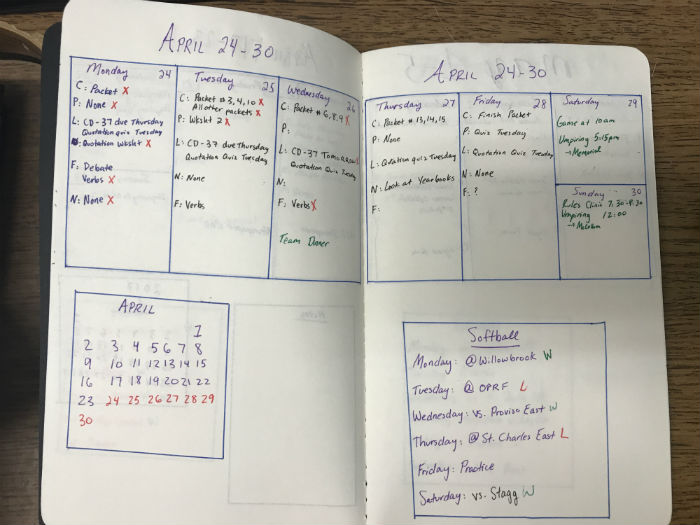Bullet journal shoots past your typical organizer
Bullet journaling, which has been growing in popularity on social media sites such as Instagram and Pinterest for months, is a do-it-yourself version of an assignment notebook. According to its website, bullet journaling is “your to-do list, sketchbook, notebook, and diary, but most likely, it will be all of the above.” A bujo (an abbreviation of “bullet journal”) can be as complex or as minimal as you want. All you need is a blank notebook, a good pen and a working brain.
Over time, bullet journaling has transformed from a organization tool into a way to artistically plan your life. Often, bujos are filled with extensive planning and various additional pages for practically anything you want. Ultimately, it is up to the artist to choose what pages they want to include in their bujo. Whether you use it to track your meals or keep lists of your favorite songs, bullet journaling gives you the freedom to be uniquely creative.
I started my journal in February because I wanted a way to keep my homework and my extracurricular events in one spot. Plus, I was looking to become a more reflective person by getting back into journaling at the end of every day. Insert the bullet journal, a perfect combination of planner and journal.
While I could have spent a good amount of money on a fancy notebook, I wanted to start simple. I didn’t really know what I was doing – I was literally copying designs from Pinterest – and I didn’t want to invest the money on an expensive journal just to rip the pages out. I bought a three pack of Moleskine notebooks from Target and a pack of G2 gel pens for around $20 in total.
My bujo consists of daily, weekly and monthly spreads. At some point in time, my goal is to start including more creative pages, such as a spending tracker or a vacation packing list, but right now keeping it simple works best for me and my busy schedule.
At the beginning of each month, I have two pages that I use to track my goals and various events for the month. My weekly spreads display everything going on in one particular week, whether it be my softball schedule or family events. I use my daily spreads to track what I did each day, what I ate and my feelings throughout the day.
The first time I began designing my bujo, it took me almost two hours to complete, but now I can finish a weekly spread, which includes my day-by-day pages, in 15 minutes. My monthly spreads take me about twenty minutes to complete. While designing your bujo can be a lengthy process, it’s one of the most rewarding, aesthetically-pleasing feelings to finally put your pen down and appreciate the work you’ve done.

I actually use two bullet journals, one for my schoolwork and one for my mental health. If I wanted to, I could have combined the two into one journal, but I wanted to completely separate my mental health from my academic responsibilities. Plus, having the extra space in both allows me to be more reflective.
I use my mental health bujo to track how I feel throughout the day, what I eat and things that I need to remember as the week goes on. Even with a busy schedule, I try to carve out five minutes before I go to bed to write down one good thing that happened to me throughout the day, as well as what I want to work on the next day.
While I could use an academic planner and a “regular” journal to keep track of my schoolwork, bullet journaling gives me a creative way to stay on top of my life. If you’re looking to start a bujo for yourself, just find yourself a notebook, search “Bujo” on Pinterest and start working.


